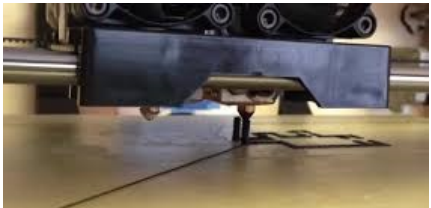Researchers in Singapore Create New Conductive 3D Printer Filament — Could Change Circuit Manufacturing Forever
 If you are like me, then you often find yourself daydreaming about the technologies of the future. My recurrent dream recently has been about a future where we print just about everything we need, whether it’s a little toy for our child, an entire car, or even a smartphone. In order for this future vision to be realized, we need to make progress on many fronts, especially that of the 3D printing materials space.
If you are like me, then you often find yourself daydreaming about the technologies of the future. My recurrent dream recently has been about a future where we print just about everything we need, whether it’s a little toy for our child, an entire car, or even a smartphone. In order for this future vision to be realized, we need to make progress on many fronts, especially that of the 3D printing materials space.
Over the last 8 months, we’ve seen a tremendous amount of innovation within this space, with one particular type of material exciting me the most. 3D printer filament, which can be printed as conductive traces, could be the spark we need to eventually realize fully functioning 3D printed electronic devices, and companies like Voxel8 and Mosaic Manufacturing seem to be leading the way. With this said, there is a new kid on the block, a group of researchers at A*STAR’s Institute of Materials Research and Engineering (IMRE), in Singapore, who may be taking conductive 3D printing to the next level.
Manufacturing seem to be leading the way. With this said, there is a new kid on the block, a group of researchers at A*STAR’s Institute of Materials Research and Engineering (IMRE), in Singapore, who may be taking conductive 3D printing to the next level.
Led by Dr Johnson Goh, IMRE scientist and Head of the Science and Engineering Research Council (SERC), scientists have reportedly been able to create a filament for 3D printing which is incredibly robust and up to 1,000 times as conductive as filaments we are all used to printing with. The researchers have also claimed that it’s 15 times more conductive than other known conductive filaments such as that of Protoplant’s.
“I believe this will revolutionize desk-top manufacturing for electronic gadgets,” said Dr Johnson Goh.
The new material has a resistivity of 0.5-1.0 Wcm, making it ideal for printing circuits while being robust enough to stand up to the high temperatures required for deposition within a typical FDM / FFF 3D printer.
“Objects in various colours, shapes and textures complete with functional circuits including wires, resistors and capacitors, could one day be printed in the comfort of one’s home,” said Dr Kwok Sen Wai, a key scientist on the research team. “We believe that our material will encourage more innovation and entrepreneurship as it will empower people to make prototypes more easily and cheaply.”
In fact, the material works so well that the researchers claim that it’s now faster, safer, and cheaper to print circuits via their filament than to use etching and soldering, while the printed circuits remain incredibly uniform with variations of no more than 5%.
The material, which is formulated by blending carbon powder with polypropylene, is said to have a superior material strength and resistance to heat than any other carbon-based conductive filament that’s currently being offered in the market.
Researchers are now seeking industrial partners to begin commercializing this new filament. If your company may be interested, researchers are also looking to license the technology through A*STAR’s commercialization arm, Exploit Technologies Pte Ltd (ETPL).
There certainly appears to be wave of innovation within this area. It will be interesting to see which companies eventually come out on top. Let’s hear your thoughts on this research, in the A*STAR Conductive Filament forum thread on 3DPB.com.
Subscribe to Our Email Newsletter
Stay up-to-date on all the latest news from the 3D printing industry and receive information and offers from third party vendors.
You May Also Like
Industrial Giant Ingersoll Rand Leads $19M Round Backing Inkbit’s AI-Driven 3D Printing
Inkbit, the Massachusetts-based original equipment manufacturer (OEM) of multi-material, AI-integrated 3D printers, has closed a $19 million financing round. Ingersoll Rand, a US giant in the industrial equipment sector, led...
3D Printing Unpeeled: Digital FDM Filament for Functional Gradients
Just published in Nature, a paper by a Seoul National University team looks at “3D printing with a 3D printed digital material filament for programming functional gradients.” Sang-Joon Ahn, Howon...
3D Printing Unpeeled: $5000 Cold Spray 3D Printer, Roland DGA & Living Materials
The AeroForge is a $5000 cold spray metal printer for copper made by a student team at Rice University. In a paper for ACS Central Science a team from Nanjing...
3D Printing News Briefs, April 27, 2024: Research, Digital Dentistry, Cycling, & More
We’re starting today’s 3D Printing News Briefs with some research into 3D printed luminescent quantum-dot polymer architectures and free-form laser beam shaping, and then on to an open source 4-axis...

































